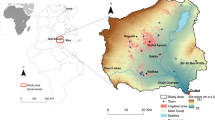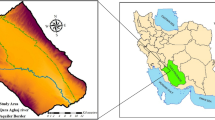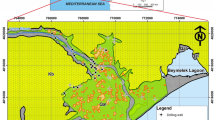Abstract
The impact of climate change and irrigation management on groundwater resources is of special concern in arid and semi-arid watersheds with intensive irrigation. Additionally, an integrated assessment of groundwater resources is essential to protect aquifers from over-exploitation. This study uses the integrated surface/subsurface hydrologic model SWAT-MODFLOW to quantify the impact of climate change and irrigation pum** schemes on groundwater drawdown for the Neishaboor watershed, Iran. Land use in the Neishaboor watershed is predominantly agricultural, therefore, irrigation plays a crucial role in the water resources balance in the study area. Within the integrated SWAT-MODFLOW model, the pumped groundwater, simulated by MODFLOW, is applied as irrigation water to the cultivated fields within the SWAT plant growth routines, with deep percolation from the soil profile bottom given to the MODFLOW cells as recharge. The developed model was calibrated and tested for the 2000–2010 and 2010–2012 periods, respectively, against measured groundwater level and streamflow data. The tested model is used to investigate the impact of climate change and groundwater pum** on groundwater drawdown under two scenarios: (1) the RCP8.5 pathway (the most pessimistic greenhouse gas emission scenario) and the continuation of the current irrigation trend, and (2) the RCP8.5 pathway with a 40% reduction in irrigation by 2035. Between 2020 and 2035, scenarios 1 and 2 produce a spatially averaged decline in groundwater levels of 20 m and 9.5 m, respectively. The model provides a framework to determine the best management practices for groundwater resources management in the region while minimizing drawdown.















Similar content being viewed by others

References
Abbaspour KC (2015) SWAT-Calibration and Uncertainty Programs (CUP): a user manual. Swiss federal institute of aquatic science and technology, Eawag, Duebendorf, Switzerland, pp 17–66
Aliyari F, Bailey RT, Tasdighi A, Dozier A, Arabi M, Zeiler K (2019) Coupled SWAT-MODFLOW model for large-scale mixed agro-urban river basins. Environ Model Softw 115:200–210. https://doi.org/10.1016/j.envsoft.2019.02.014
Aliyari F, Bailey RT, Arabi M (2021) Appraising climate change impacts on future water resources and agricultural productivity in agro-urban river basins. Sci Total Environ 788:147717. https://doi.org/10.1016/j.scitotenv.2021.147717
Alizadeh A, Izady A, Davary K, Ziaei AN, Akhavan S, Hamidi Z (2013) Estimation of actual evapotranspiration at regional-annual scale using SWAT Iranian. J Irrigat Drain 2(7):243–258 (in Persian)
Bailey RT, Wible TC, Arabi M, Records RM, Ditty J (2016) Assessing regional-scale spatio-temporal patterns of groundwater-surface water interactions using a coupled SWAT-MODFLOW model. Hydrol Process 30(23):4420–4433. https://doi.org/10.1002/hyp.10933
Chunn D, Faramarzi M, Smerdon B, Alessi DS (2019) Application of an Integrated SWAT–MODFLOW model to evaluate potential impacts of climate change and water withdrawals on groundwater–surface water interactions in West-Central Alberta. Water 11(1):110. https://doi.org/10.3390/w11010110
Doherty J (2006) PEST Model-Independent Parameter Estimation, V10. 1, Papadopulos. SS, Inc., Bethesda, Md:1-336 (Available at http://www.sspa.com/pest/)
Green TR, Taniguchi M, Kooi H, Gurdak JJ, Allen DM, Hiscock KM, Treidel H, Aureli A (2011) Beneath the surface of global change: Impacts of climate change on groundwater. J Hydrol 405(3–4):532–560. https://doi.org/10.1016/j.jhydrol.2011.05.002
Green TR (2016) Linking Climate Change and Groundwater. In: Jakeman AJ, Barreteau O, Hunt RJ, Rinaudo JD, Ross A (eds) Integrated Groundwater Management. Springer, Cham, pp 97–141. https://doi.org/10.1007/978-3-319-23576-9_5
Guzman JA, Moriasi DN, Gowda PH, Steiner JL, Starks PJ, Arnold JG, Srinivasan R (2015) A model integration framework for linking SWAT and MODFLOW. Environ Model Softw 73:103–116. https://doi.org/10.1016/j.envsoft.2015.08.011
Izady A, Davary K, Alizadeh A, Ziaei AN, Alipoor A, Joodavi A, Brusseau ML (2014) A framework toward develo** a groundwater conceptual model. Arab J Geosci 7:3611–3631. https://doi.org/10.1007/s12517-013-0971-9
Izady A, Davary K, Alizadeh A, Ziaei AN, Akhavan S, Alipoor A, Joodavi A, Brusseau ML (2015) Groundwater conceptualization and modeling using distributed SWAT-based recharge for the semi-arid agricultural Neishaboor plain. Iran Hydrogeol J 23:47–68. https://doi.org/10.1007/s10040-014-1219-9
Izady A, Abdalla O, Mahabbati A (2016) Dynamic panel-data-based groundwater level prediction and decomposition in an arid hardrock–alluvium aquifer. Environ Earth Sci 75(18):1–13. https://doi.org/10.1007/s12665-016-6059-6
Izady A, Abdalla O, Joodavi A, Karimi A, Chen M, Tompson A (2017) Groundwater recharge estimation in arid hardrock-alluvium aquifers using combined water-table fluctuation and groundwater balance approaches. Hydrol Process 31(19):3437–3451. https://doi.org/10.1002/hyp.11270
Kim NW, Chung IM, Won YS, Arnold JG (2008) Development and application of the integrated SWAT-MODFLOW model. J Hydrol 356:1–16. https://doi.org/10.1016/j.jhydrol.2008.02.024
Kollet SJ, Maxwell RM (2006) Integrated surface-groundwater flow modeling: a free-surface overland flow boundary condition in a parallel groundwater flow model. Adv Water Resour 29(7):945–958. https://doi.org/10.1016/j.advwatres.2005.08.006
Kumar CP (2016) Assessing the impact of climate change on groundwater resources. IWRA (Ind) J 5(1):3–11
Kundzewicz ZW, Mata LJ, Arnell NW, Doll P, Kabat P, Jimenez B, Miller K, Oki T, Zekai S, Shiklomanov I (2007) Freshwater resources and their management. Cambridge University Press, Cambridge 173–210
Markstrom SL, Niswonger RG, Regan RS, Prudic DE, Barlow PM (2008) GSFLOW–Coupled Ground–water and Surface-water FLOW model based on the integration of the precipitation-runoff modeling system (PRMS) and the modular ground-water flow model (MODFLOW–2005). US Geol Surv Tech Methods 6:240
Nash JE, Sutcliffe JV (1970) River flow forecasting through conceptual models. Part 1—A discussion of principles. J Hydrol 10(3):282–290. https://doi.org/10.1016/0022-1694(70)90255-6
Nazarieh F, Ansari H, Ziaei AN, Izady A, Davari K, Brunner P (2018) Spatial and temporal dynamics of deep percolation, lag time and recharge in an irrigated semi-arid region. Hydrogeol J 26(7):2507–2520. https://doi.org/10.1007/s10040-018-1789-z
Paniconi C, Wood EF (1993) A detailed model for simulation of catchment scale subsurface hydrologic processes. Water Resour Res 29(6):1601–1620. https://doi.org/10.1029/92WR02333
Park S (2018) Enhancement of coupled surface/subsurface flow models in watersheds: Analysis, Model development, optimization, and user accessibility. Doctoral dissertation. Colorado State University
Refsgaard JC, Storm B, Refsgaard A (1995) Recent developments of the Systeme Hydrologique Europeen (SHE) towards the MIKE SHE. Modelling and Management of Sustainable Basin-Scale Water Resource Systems Proc. International Symposium, Colorado
Rodell M, Famiglietti JS, Wiese DN, Reager JT, Beaudoing HK, Landerer FW, Lo MH (2018) Emerging trends in global freshwater availability. Nature 557(7707):651–659. https://doi.org/10.1038/s41586-018-0123-1
Seyfi S (2018) Prediction of temporal changes of inlet sediment to Torogh dam reservoir using IHACRES model (In Persian). Master Thesis, Ferdowsi University of Mashhad
Sophocleous MA, Koelliker JK, Govindaraju RS, Birdie T, Ramireddygari SR, Perkins SP (1999) Integrated numerical modeling for basin-wide water management: the case of the Rattlesnake Creek basin in south-central Kansas. J Hydrol 214(1–4):179–196. https://doi.org/10.1016/S0022-1694(98)00289-3
Therrien R, McLaren RG, Sudicky EA, Panday SM (2010) HydroGeoSphere, A Three-dimensional Numerical Model Describing Fully-integrated Subsurface and Surface Flow and Solute Transport. Groundwater Simulations Group, University of Waterloo, Waterloo, ON, pp 1–456
Tian Y, **ong J, He X, Pi X, Jiang S, Han F, Zheng Y (2018) Joint operation of surface water and groundwater reservoirs to address water conflicts in arid regions: an integrated modeling study. Water 10(8):1105. https://doi.org/10.3390/w10081105
Triana JSA, Chu ML, Guzman JA, Moriasi DN, Steiner JL (2020) Evaluating the risks of groundwater extraction in an agricultural landscape under different climate projections. Water 12(2):400. https://doi.org/10.3390/w12020400
Van Vuuren DP, Edmonds J, Kainuma M, Riahi K, Thomson A, Hibbard K, Hurtt GC, Kram T, Krey V, Lamarque JF, Masui T, Meinshausen M, Nakicenovic N, Smith SJ, Rose SK (2011) The representative concentration pathways: an overview. Clim Change 109(1):5–31. https://doi.org/10.1007/s10584-011-0148-z
Warner SD (2007) Climate change, sustainability, and ground water remediation: the connection. Ground Water Monit Rem 27(4):50–52. https://doi.org/10.1111/j.1745-6592.2007.00175.x
Funding
The authors have not disclosed any funding.
Author information
Authors and Affiliations
Contributions
Alieh Saadatpour wrote the main manuscript text. Ryan T. Bailey, Azizallah Izady, and Seonggyu Park reviewed the manuscript. Amin Alizadeh and Ali Naghi Ziaei were project supervisor. Ryan T. Bailey and Azizallah Izady were project advisors.
Corresponding author
Ethics declarations
Conflict of interests
The authors have not disclosed any competing interests.
Additional information
Publisher's Note
Springer Nature remains neutral with regard to jurisdictional claims in published maps and institutional affiliations.
Rights and permissions
Springer Nature or its licensor (e.g. a society or other partner) holds exclusive rights to this article under a publishing agreement with the author(s) or other rightsholder(s); author self-archiving of the accepted manuscript version of this article is solely governed by the terms of such publishing agreement and applicable law.
About this article
Cite this article
Saadatpour, A., Izady, A., Bailey, R.T. et al. Quantifying the impact of climate change and irrigation management on groundwater in an arid region with intensive groundwater abstraction (Case study: Neishaboor watershed, Iran). Environ Earth Sci 81, 531 (2022). https://doi.org/10.1007/s12665-022-10662-9
Received:
Accepted:
Published:
DOI: https://doi.org/10.1007/s12665-022-10662-9



